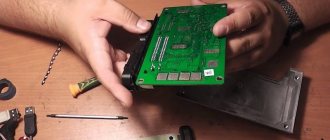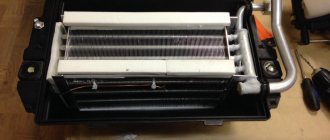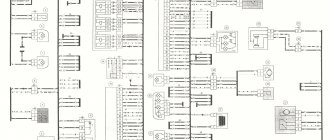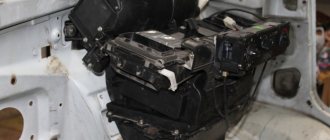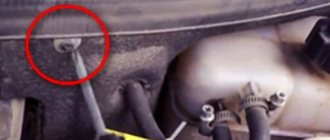When operating modern vehicles equipped with automatic transmissions, the transmission oil, as well as working units and parts of the automatic transmission, gradually become contaminated. Harmful sediments in the form of metal dust, shavings, fragments, combustion products and breakdown of friction clutches accumulate on working surfaces, filter screens, as well as in the cavities and channels of the hydraulic system. Flushing the automatic transmission is a necessary procedure to restore the stability of the transmission.
Why do you need to flush the automatic transmission?
During operation of the automatic transmission, the amount of mud deposits increases, which causes failure of both individual parts and the mechanism as a whole. Some car enthusiasts believe that they can get by with simply replacing the transmission oil and oil filter. However, as practice shows, in order to restore the stable functioning of an automatic transmission, simply replacing the lubricant is not always enough. To independently adjust the operation of the automatic transmission, washing the automatic transmission yourself is the best solution.
What is the essence of such an action as automatic transmission flushing? The answer is simple: an accessible way to clean the cavities of the gearbox from accumulated dirt is determined. The most commonly used method is flushing the machine’s channel system using lubricating fluid flows. Sometimes a special flushing agent or automatic transmission flushing fluid (Liqui Moly) is added to the transmission oil.
If this does not help, the gearbox is completely disassembled. After which, each part is cleaned manually using gasoline and compressed air.
Each of the described methods is successfully used in practice. The results of proper cleaning of the automatic transmission are noticeable in the following manifestations:
- The likelihood of automatic transmission breakdowns is reduced.
- The service life of the entire mechanism increases.
- The operation of the automatic transmission is corrected.
In order for flushing an automatic transmission to achieve maximum efficiency, it is necessary to perform each operation competently and accurately.
Hydraulic unit care
Hydraulic unit, inside view
With prolonged use of the vehicle, the transmission fluid gradually becomes contaminated. The result of this is the failure of the components of the gearbox.
When servicing the automatic transmission for the first time, it may be necessary to replace the solenoids and clean the automatic transmission valve body. This allows you to extend the service life of the transmission. The cost of repairing the hydraulic unit depends on the nature of the existing breakdown. Malfunctions of this device mainly occur as a result of overheating of the transmission and the use of dirty oil. Overheating of the gearbox leads to deformation of its parts, the valve body, the repair of which may involve replacing springs and valves.
What is dangerous about the presence of sediment in the form of metal shavings and combustion products in oil? The presence of these substances helps reduce the service life of the gearbox. In particular, filters and hydraulic system channels become clogged. The correct option in this situation is to flush the automatic transmission. Carrying out this procedure helps restore the stability of the transmission system.
In what other cases is flushing required? We list the main reasons for the need to clean the automatic transmission:
- gears are difficult to shift;
- the appearance of shocks during acceleration;
- instability of the functioning of the checkpoint.
If this procedure does not help solve the problem, it is advisable to order automatic transmission diagnostics, the results of which require disassembling the box and replacing worn parts.
Thus, the oil constantly circulates through the transmission channels; over time, wear products form in it, which clog the valve body channels. Because of this, the solenoids fail. As a result, the box begins to push when switching. A procedure such as flushing the gearbox can solve the problem.
How often do you need to flush the automatic transmission?
During active use of the gearbox, it is recommended to flush the automatic transmission, in particular, to clean the valve body channels, simultaneously with a complete change of transmission oil (automatic transmission oil change with flushing). The service life of a vehicle transmission directly depends on the frequency of these activities. Flushing the automatic transmission when changing the oil means that the frequency of work is 30 - 70 thousand km of the distance traveled. The interval between automatic transmission maintenance activities is set depending on the operating conditions of the vehicle.
What's the result?
As you can see, the valve body (automatic transmission valve plate) is a complex mechanism. The device consists of plates (tracks-channels), valves, solenoids, etc. In this case, the hydraulic unit controls the operation of the clutches and clutches, that is, it is actually responsible for engaging gears and modes.
If such symptoms appear, in parallel with changing the automatic transmission oil and filter, it is also strongly recommended to flush the valve body (unless problems with the gearbox have another obvious cause). Also, automatic transmission repair specialists recommend flushing the valve body every 80-100 thousand km. for preventive purposes, which allows you to increase the service life of the device and the entire automatic transmission as a whole.
Why the automatic transmission kicks, the automatic transmission jerks when changing gears, jerks, jerks and impacts occur in the automatic transmission: the main reasons.
Automatic transmission slipping when changing gears: the main reasons why an automatic transmission slips. Box diagnostics, troubleshooting.
A jolt in the automatic transmission, the appearance of jerks when shifting gears of the automatic transmission, jolts of the automatic transmission in place: the main reasons for such malfunctions of the automatic transmission.
Automatic transmission valve plate (valve unit): design of the valve body, purpose, principle of operation. Valve unit malfunctions, causes of breakdowns, diagnostics and repair.
The automatic transmission jerks: the main causes of jerks, kicks, and shocks in the automatic transmission. Diagnostics of faults, tips and recommendations.
When and why you need to change the oil in an automatic transmission. Changing transmission oil in automatic transmission Polo Sedan. Tips and tricks.
Source
What you need to prepare for washing the automatic transmission
This event is best carried out in specialized workshops. Most service companies are equipped with special washing devices, with the help of which the unit is washed at the proper professional level. If during diagnostics it turns out that it is necessary to disassemble the automatic transmission and change some parts and components, the box is rebuilt, all its elements are washed in gasoline, and the channels are purged with compressed air.
If you decide to flush the automatic transmission yourself, you need to create the conditions and acquire consumables, auxiliary tools, and accessories:
- Transmission fluid in double volume (the first portion of ATP oil will be used for flushing the unit, the second - for refueling, respectively).
- Adjustable wrenches, sockets, polygons, gasoline, screwdrivers, pump.
- Bucket or basin for waste material.
- Cotton rags.
- Observation deck, overpass.
How much does it cost to completely flush an automatic transmission valve body: the price of a service approach
To return the unit to operability, it will be necessary to flush the automatic transmission valve body, the price of which can vary greatly depending on several factors:
- Designs, brands and models of automatic transmissions;
- Degree of contamination of the hydraulic unit;
- Makes and models of the car (on a number of cars, access to this unit is very difficult, as a result of which even simple dismantling of the automatic transmission will take a lot of effort and time from the technician.
In this regard, a complete and thorough washing of the valve body, during which this unit is completely disassembled and each of its parts is washed separately manually, is not always resorted to, but only then there are special indications for this, primarily, systematic malfunctions in the operation of the automatic transmission caused by clogging of valve body channels.
Routine cleaning of this device is carried out without disassembling it and even without removing it from the car: the oil is drained from the automatic transmission and a special washing liquid is passed through the valve body under pressure. Achieving an ideal result with this technology is impossible, but it significantly reduces the cost of this procedure.
Washing the automatic transmission without removing it from the machine
This procedure is carried out using a special device. Standard list of work carried out by service station employees:
- First, the used old oil is drained. In order for the maximum amount of used fluid to flow out, the automatic transmission pan is removed and the drain plug is unscrewed.
- After draining the liquid, all parts are installed in their original places.
- A device filled with new transmission oil is connected.
- The engine starts.
- The motor runs for at least 15 minutes.
- At this time, oil under pressure passes through all channels of the automatic transmission hydraulic system.
- The ATF oil from the automatic transmission is drained again.
- The worn oil filter is removed and a new filter element is installed in its place.
- The automatic transmission pan gasket is being replaced.
- Fresh transmission oil is added.
Full flow cleaning
This method includes cleaning the automatic transmission along with changing the oil. First, the waste is drained and the filter is replaced. The next step is to flush the box and fill in new lubricant.
Washing the automation is carried out on a lift or inspection pit, since in this situation it is necessary to remove the pan to allow residual fluid to leak out and replace the oil filter. At service stations they use a washing unit. It contains pipes that are connected to the automatic transmission cooling system.
After this, the engine is started and left to run for 20 minutes. At the end of this operation, the flushing liquid flows into the pan. Then it is carefully unscrewed and the waste is drained. In this case, solid metal residues and slags flow out thanks to the flushing liquid.
Next, replace the pan gasket and filter. Using the automatic transmission oil filler line, new car oil is filled to a specific mark. The flushing unit connected to the cooling system is left in its current position.
The motor starts, and the lubricant is circulated through the box several times, and then drains through the installed flushing equipment hose.
The procedure ends after the amount of oil poured is compared with the volume of oil flowing out. When washing the box, it is recommended to switch speeds to modes D, R and vice versa, to completely wash the gears and parts.
This method is used only in the warm season, since the operating temperature of the flushing liquid is -10°C for the automation system.
Features of complicated box cleaning
If the gearbox is removed from the car for subsequent repairs, it is recommended to wash the automatic transmission cavities not in the standard way, but using more complex manipulations. Procedure:
- Drain the oil from the box.
- Remove the automatic transmission from the vehicle.
- Completely disassemble the mechanism.
- Thoroughly rinse each element in gasoline (diesel oil, kerosene).
- Blowing the valve body channels with compressed air.
- Replacement of consumable spare parts (filter elements, gaskets, seals, seals, etc.).
- Reassembling the automatic transmission to its original condition.
- Installing an automatic transmission on a car.
- Filling the system with ATF transmission fluid.
- Running in the automatic transmission.
Important: When breaking in a vehicle, you must adhere to gentle conditions, avoid sudden maneuvers, sharp turns, emergency braking and other increased loads. The automatic transmission adaptation process lasts several days (from 4 to 7).
Self-cleaning of the valve body
Self-cleaning of the automatic transmission hydraulic system with flushing fluid includes the following steps:
- Unscrew the plug and drain the oil, then install it back;
- Remove the pan cover and the plug on the electrical connector;
- At the next stage, disconnect the connector by turning the plastic lock;
- Remove the adapter on the connector;
- We dismantle the valve body. Here you need to be extremely careful, since when working with the automatic transmission unit it is necessary to maintain cleanliness and prevent dirt and dust from entering;
- Unscrew the bolts on the back and front sides of the valve body;
- Carefully remove the board;
- After removing the board, you need to unscrew a few more bolts and pull out the upper part of the mechanism;
- Raise the thin plate a little;
- We carefully unwind the remaining plates, since there are small springs under them;
- We remove the rods and place them on the table or floor in the installation position so that there are no problems when assembling the valve body;
- Then we wash it with abro carb cleaner;
- We assemble the parts in the reverse order and install new spare parts to replace the damaged mechanisms;
- We start the power unit and leave it running at idle speed so that the oil circulates through the valve body;
- We switch the selector lever to all modes and at the same time observe a short pause between gear changes.
Job is done.
Automatic transmission radiator flushing
There are many discussions devoted to this topic among experienced motorists. Some reputable drivers recommend regularly cleaning the automatic transmission cooling circuit tubes. According to others, this device should be replaced with a new copy. In any case, each car owner will make his own decision. The design of the radiator is a complex system. If the conductivity of the lines is poor, the heat exchange of the transmission oil in the hydraulic system of the automatic transmission is disrupted.
What is a valve body in an automatic transmission?
The hydraulic plate is called the “brains” of automatic transmissions, not only for the external resemblance of the complex channels to the convolutions of the brain. Before the advent of control electronics in the 1980s, the valve body decided which automatic transmission unit needed to be connected to operation. Now the valve plate is controlled by the computer, maintains pressure in the system and distributes fluid flows from the oil pump to the actuators: clutch packs and torque converter lock-up (GDT). The hydraulic unit includes:
- a metal plate with a labyrinth of channels through which oil passes;
- solenoids;
- pressure regulators;
- spool valves;
- sensors;
- filters;
- hydraulic accumulators;
- wiring;
- separator plate, seals.
ZF simultaneously made the evolution of the machines and created a new problem for repair by introducing an electronic board into the design of the valve body.
Operating principle of the automatic transmission valve body
The automatic transmission valve body maintains pressure in the system using a group of valves:
- solenoids open and close channels for the passage of fluid to the clutches and gas turbine engine;
- the regulators create the linear pressure of the main line, necessary for lubrication and cooling of the box, as well as for locking the clutches. The pressure increases when the car accelerates and reverse gear is engaged, and decreases when braking;
- synchronizers prevent shocks when changing gears by regulating the sequence of step transitions;
- adjustment valves change the pressure value to improve the operational parameters of the automatic transmission;
- hydraulic accumulators soften shocks in the box, maintaining the inertia of compression of the clutches due to the tension of the springs.
The signal to open the solenoids comes from the ECU. The position of other valves depends on spring tension and fluid pressure. The pressure inside the valve body varies depending on the throttle position: with increased torque, the linear pressure increases, which prevents slipping.
Flushing the automatic transmission torque converter
This procedure is carried out only after cutting the “donut”. After opening the case, all parts and components of the mechanism are carefully inspected and analyzed to eliminate breakdowns and defects.
The following elements of the automatic transmission torque converter are checked and cleaned:
- Turbine blades.
- O-rings.
- Oil seals.
- Clutch elements.
After cleaning the internal parts, the torque converter housing is carefully welded. Basic requirements for the weld: ensuring tightness and restoring the aesthetic appearance of the assembled product.
Removing/installing, cutting, washing, welding the torque converter housing - all these operations can only be done by experienced service center specialists. It is not recommended to do this work yourself without the necessary skills at home.
Al4 automatic transmission valve body repair
Annual scheduled repairs must take place in a service station. Maintenance involves removing the Al4 valve body, washing, replacing faulty parts, completely replacing the lubricating fluid (Mobil ATF LT 71141) and the filter device (No. 144010).
The filter device, with proper operation, timely topping up and changing the lubricant, according to experienced mechanics, survives a period of 80,000 kilometers and can remain clean.
Removal
Before removing the Al4 automatic transmission valve body, you need to drive the vehicle for 10 minutes. Then drive into a pit. The first steps will be no different from those for replacing the lubricant.
- Unscrew the drain plug on the automatic transmission pan.
- Place a container for lubricating fluid, which will flow under pressure from the hole formed.
- Wait until the oil stops dripping.
- Unscrew the automatic transmission pan. First clean it of metal shavings and leave to dry.
- Disconnect the terminals that the car owner can see. When removing the rod and ratchet with a finger, you need to remember what position it was in or mark it by scratching a line with a metal core. In the correct position it will always be motionless. If there is play, then it will need to be reinstalled when the car owner reassembles the automatic transmission valve body.
- Unscrew the bolts that hold the valve body with the Al4 automatic transmission.
- Pull out the hydraulic plate.
Diagnostics and repair of Mazda 6 automatic transmission
Flushing
After the hydraulic unit has been pulled out, it must be completely disassembled and washed. To do this, the car owner can use various cleaning products. Clean the fine filter if it is dirty. After washing, you need to assemble the hydraulic unit. The bolts are tightened from the middle to the edges. Tighten to a torque of 0.8 daNm.
It should be washed in white spirit. If after the first cleaning the solution is dirty, you need to fill in another one and rinse the hydraulic unit again. Since inside the holes for the valves there may be fumes and wear residues of parts that enter there along with the hydraulic fluid during operation of the Al4 automatic transmission.
After flushing, it will be necessary to replace the solenoids and valves. Then adjust them. Carry out the replacement carefully and install everything in its place so that the automatic transmission does not slow down when changing gears after repair.
Solenoids
New solenoids in the al4 automatic transmission are changed in pairs. It is advisable to also change the old ones in pairs. After replacement, it will be necessary to carry out adjustment with a special program. How to do this using the adjustment utility will be described in a special block.
The temperature sensor will need to be replaced. If it is faulty, the vehicle may go into emergency mode and will not start.
Reasons for automatic transmission going into emergency mode and ways to reset the error
valves
It is advisable to replace all solenoid valves in Al4 automatic transmissions. Since one worn valve can lead to an imbalance in pressure causing new ones to fail.
The valve pistons also need to be cleaned in white spirit until shiny. They must fit tightly to the walls of the channel and at the same time fall into it under their own weight.
Solenoid valves that need to be replaced in the valve body:
- CS is a safety valve. Responsible for controlling pressure up to 2.5 MPa;
- R3 – works with control of the fluid supply pressure to the torque converter and in the lubrication line of the mechanism;
- R2 – limits pressure to 0.3 mPa;
- R1 – sets the limit to 0.175 mPa;
- VM – automatic transmission switch spool;
- VS – four speed switch spools, two – supply oil to the actuators.
After replacing all components, it is necessary to assemble and reinstall the valve body. When installing, you must make sure that all wires are inside and not pinched. Now you can proceed to the procedure for completely changing the ATF.
- Screw in the drain plug. All components that have rubber gaskets must be replaced with new ones.
- Fill in as much lubricant as was drained.
- Start the engine.
- Remove the hose from the radiator return and place a five-liter canister.
- Wait until fresh oil comes out. Turn off the engine.
- Pour in the same amount as was drained this time.
Ford automatic transmission repair
After cleaning the valve body of the Al4 automatic transmission and changing the oil, you will need to take the car for a drive. Check level. If it is below the Hot mark on the dipstick, then experts recommend topping up.
Adjustment
To make sure that the gears shift correctly, you need to start the engine. Then press the brake pedal. After this, move the slide through all selector gears.
To adjust the valve body, you need to tighten the screw on the right one turn. When scrolling a full turn, the pressure rises to 0.3 MPa. The pressure should not be too much. Therefore, it is best to immediately tighten it not a full turn, but a quarter turn.
For new solenoids, it is necessary to reflash the Al4 automatic transmission control unit. The solenoids are activated using the new Renault Can Clip software.
Attention! Old software versions are not compatible with new valve body valves.
Do-it-yourself repair of automatic transmission a604 (41te) and repair kit for solenoid unit
The automatic transmission A604 was developed by Chrysler engineers for installation on front-wheel drive configurations of Dodge, Plymouth and Chrysler, and on the limited edition Mitsibishi. The four-speed transmission was the first automatic transmission in the United States to use automatic hydraulic control. The computer allows you to adjust the gear shift order to suit the driving style of a particular driver.
Diagnostics of valve body 5HP19
If you do diagnostics at a service station, the valve body will go through the following procedures to identify faults:
- checking solenoids on a special stand;
- disassembling the stove and cleaning it;
- vacuum test for the development of hydraulic plate valves and channels.
It will then be assembled, installed in 5HP19 and given to you. But you can disassemble the gearbox yourself. If you know for sure that the 5HP19 is new and the hydraulic plate is not worn out, then it is enough to rinse it.
If after flushing you continue to be bothered by slow gear shifts, noise and vibration, it is better to contact a service center.
Signs of valve body failure
The main problem of the valve body is faulty solenoids. When the solenoid valve cross-section becomes dirty, it does not allow enough liquid to pass through, as a result: the pressure in the system drops, the discs slip, burn, contaminating the oil even more. Worn solenoids require repair to prevent:
- breakdown of the oil pump, which leads to oil starvation, transmission overheating, delays in gear shifting, and the appearance of extraneous sounds;
- deterioration of gas turbine engine blocking and the appearance of jerks when accelerating, slow acceleration, increased fuel consumption;
- jumps in engine speed, failures during acceleration.
Other signs of a valve body problem:
- jolts in first or reverse gear;
- slipping when starting to move “hot”;
- errors on the on-board computer panel;
- oil leakage.
Torque converter lock-up clutch control
The blocking is controlled by finely tuned TCC solenoids using the EGS signal:
- The electronic unit analyzes information from the gas pedal position sensors, throttle opening degree, etc.
- Transmits a PWM pulse to the TCC to convert the current into the corresponding pressure.
- Pressure from the solenoid flows through the input shaft into the cavity behind the locking piston.
- Between the housing and the clutches the pressure is released, and between the turbine and the clutches it increases.
- The discs are pressed against the body with the required clearance.
- The locking is turned off as the speed decreases or when the oil heats up above 140℃. The oil is “pumped out” into the solenoid until the next signal. If the fluid is contaminated with friction dust, the solenoid valve quickly becomes clogged and requires repair.
The computer does not know how to “read” the degree of wear of the clutch, and continues to operate the lock in normal mode even if the disk is completely worn out. The valve body and radiator become clogged. Rubber bands and seals are leaking. The Mercedes transmission is increasingly overheating, requiring urgent repairs.
In the Mercedes 722.9 automatic transmission, torque converter lock-up slip is activated already in first gear, which is essentially a controlled friction clutch. But this solution leads to oil contamination after 60,000 km, and the donut comes in for repair after 100 - 150,000 km.
Used or contract automatic transmission torque converter
It is difficult to find new spare parts for Mercedes 722.6 boxes. These are mostly factory remanufactured parts. Purchasing a repaired torque converter for a Mercedes automatic transmission is more expensive than a contract one, and is comparable to the cost of repairing an original donut. When looking for a cheap used unit, you can run into unscrupulous repairs and cheap spare parts instead of the original.
Contract Mercedes torque converters are supplied from Europe or the USA, where they are removed from serviceable cars. Due to the fact that foreign automatic transmissions were not fed with Russian fuel and did not suffer on Russian roads, their residual life is at least 100,000 km. But you need to understand that a used unit will most likely have signs of wear and other defects that arose during operation.
On our website you can order a contract torque converter for a Mercedes automatic transmission. To select a unit, you need to know the car model, engine type and VIN code. After completing the application, we will be able to name the price and delivery time of the goods. Delivery within Russia and CIS countries is free. After receiving your Mercedes torque converter, you will have 90 days to check its performance.
Which automatic transmissions are installed on?
This type of machine can be seen on cars such as:
- Audi;
- Volkswagen.
Sometimes the 5HP19 classification is different. For example, on some VAG 5HP19 it is called 01V, on others it is called 01L. It depends on what kind of drive the car has: front-wheel drive, rear-wheel drive or all-wheel drive.
Attention! When I bought the Audi A4 Quattro, I thought that it would take a year or two and then a major overhaul. It happened that I overheated the machine and abused it mercilessly in the winter. But before major repairs, 5HP19 lived for 4 years. Of course, I did not neglect oil changes and maintenance. But after about a year and a half, I had to flush the 5HP19 valve body myself.
I will tell you how to do this further. In the meantime, tell me, what kind of cars did you have with this machine gun?
Automatic transmission Chrysler A604 (40TE, 41TE)
They differ for A604 before 2003 and for modifications 40TE/41TE after 2004.
Typical problems with the hardware of the A604 automatic transmission:
— Front planetary gear, (Front Planet 272582)
In age automatic transmissions there are:
— various problems with the Differential bearings (272717),
— The rubber-coated piston, Retainer Piston, Underdrive Clutch (272960) changes more often than others along with
— Drum, Drum Input Retainer Clutch (272554A).
These transmissions operate for a long time and reliably, provided that the oil is changed annually (or every 30 tkm) and its level and quality are monitored. If the oil becomes dirty too quickly, you should listen to the operation of the torque converter and not be late in repairing it.
Chrysler OBD-II Trouble Codes. The cost and availability of the items you need can be checked in the online store by clicking on the number on the orange background.
Which cars were installed on this family of automatic transmissions:
| Auto | Model | Year of issue | Country of assembly | Engine | Model | Alternative name | |
| CHRYSLER | CIRRUS | 95-00 | MEX USA | 4 SP FWD | L4 2.4L V6 2.5L | 41TE | A604 |
| CHRYSLER | LEBARON | 95 | 4 SP FWD | V6 3.0L | 41TE | A604 | |
| CHRYSLER | PACIFICA | 04-07 | CAN | 4 SP F/AWD | V6 3.5L 3.8L | 41TE | A604 |
| CHRYSLER | PT CRUISER | 01-09 | AUT MEX | 4 SP FWD | L4 2.0L/2.4L | 41TE | A604 |
| CHRYSLER | SEBRING/SEBRING CONVERT. | 00-10 | USA MEX | 4 SP FWD | L4 2.4L 2.5L V6 2.7L 3.0L | 41TE | A604 |
| CHRYSLER | SEBRING | 05-09 | CHNUKR | 4 SP FWD | L4 2.0L 2.4L V6 2.7L | 41TE | A604 |
| CHRYSLER | TOWN&COUNTRY | 95-.. | CAN USA | 4 SP F/AWD | V6 3.3L 3.8L | 41TE | A604 |
| CHRYSLER | VOYAGER | 01-.. | AUT CAN CHN TWN USA | 4 SP FWD | L4 2.4L 2.8L V6 3.0L 3.3L 3.8L | 41TE | A604 |
| DODGE | AVENGER | 95-00 | USA | 4 SP FWD | L4 2.0L V6 2.5L | 41TE | A604 |
| DODGE | AVENGER | 07-10 | USA | 4 SP FWD | L4 2.4L V6 2.7L | 41TE | A604 |
| DODGE | CARAVAN/GRAND CARAVAN | 95-.. | CAN CHN USA | 4 SP F/AWD | L4 2.4L V6 3.0L 3.3L 3.8L | 41TE | A604 |
| DODGE | JOURNEY | 08-.. | MEX | 4 SP FWD | L4 2.4L V6 2.7L | 41TE | A604 |
| DODGE | NEON | 01-06 | USA VEN | 4 SP FWD | L4 2.0L | 41TE | A604 |
| DODGE | STRATUS | 95-06 | MEX USA | 4 SP FWD | L4 2.0L/2.4L V6 2.5L 2.7L | 41TE | A604 |
| EAGLE | TALON | 95-98 | USA | 4 SP FWD | L4 2.0L V6 2.5L NON TURBO | 41TE | A604 |
| MITSUBISHI | ECLIPSE | 95-98 | 4 SP FWD | L4 2.0L | 41TE | A604 | |
| MITSUBISHI | GALANT | 94-98 | 4 SP FWD | V6 2.5L | 41TE | A604 | |
| PLYMOUTH | BREEZE | 95-00 | USA | 4 SP F/AWD | L4 2.0L 2.4L | 41TE | A604 |
| PLYMOUTH | VOYAGER/GRAND VOYAGER | 95-00 | 4 SP FWD | L4 2.4L V6 3.0L/3.3L/3.8L | 41TE | A604 | |
| VOLGA | SIBER | 08-.. | RUS | 4 SP FWD | L4 2.4L | 41TE |


